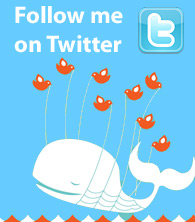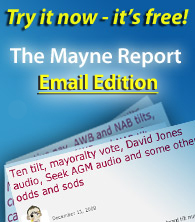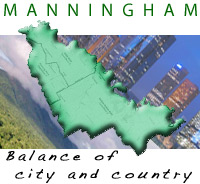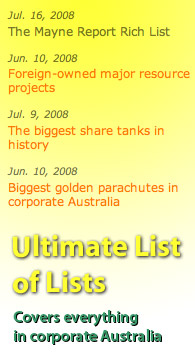Macquarie and Rupert's prediction of Howard
July 22, 2008
Here are Stephen Mayne's four stories from the Crikey edition on Wednesday, 17 May, 2006.
1. Rupert predicts Howard will go
By Stephen Mayne
Have a listen to Michael Rowland's story on The World Today this afternoon when it appears online because Rupert Murdoch has made some unguarded remarks to the ABC's Washington correspondent suggesting it would be a good time for John Howard to retire while "on top of his game".
Eleanor Hall immediately interviewed Murdoch biographer Neil Chenoweth pursuing the question of whether the Sun King wants Peter Costello installed sooner rather than later and whether this ties in with proposed changes to Australia's media ownership laws.
For mine, I reckon Rupert was just backing up his closest friend in Australia, a certain Piers Akerman. The two still exchange birthday presents and it wouldn't surprise at all if Rupert was the primary Akerman source for last Sunday's column predicting an elegant departure for the PM shortly before Christmas.
You see, Rupert was invited to the special John Howard tribute dinner at the White House last night which further confirmed the impression that this trip is a farewell lap of honour.
Given the closeness of Murdoch's media machine to the Bush White House – Fox News operative Tony Snow is Dubya's new official spokesman – this could well be the source of the leak.
Sure, John Howard keeps his counsel close in Australia, but to get the sort of lavish treatment in Washington would have required communication that there was unlikely to be another trip.
This information presumably prompted Rupert's decision to attend the lavish White House tribute dinner and then the cat was let out of the bag when Rowland door-stopped him on the way in.
Asked if he expected Howard to stick around longer than George Bush, Rupert said: "The Prime Minister could if he wanted to, but I doubt it."
"I would like to see him stay on, he's had 10 years ... he's on top of his form and it's much better to go out that way."
Rupert cited Margaret Thatcher as an example of someone who stayed too long and said departing with an election loss was always the worst possible outcome.
As expected, Rupert described the Australia-US relationship as "very, very close – they have never been closer". He also laid it on thick during his speech, praising the PM for his "vision and courage".
Gee, supporting the folly of the Rupert-backed invasion of Iraq sure does elicit plenty of praise these days.
9. Why Australia needs more Millionaire Factories
By Stephen Mayne
At one level, Macquarie Bank is the perfect example of how a successful Australian business should emerge and grow. Born out of an English merchant bank in the early 1970s, Macquarie's Australian executives broke free from these shackles and then successfully competed against the world's biggest players in the domestic investment banking market.
Having grown as big as was possible in Australia, Macquarie then exported their model overseas and are now generating an increasing amount of offshore income for its Australian shareholders. One telling statistic from yesterday's result was that the Asian stockbroking business out-performed its Australian counterpart for the first time. Wouldn't it be nice if all those happy players in Australia's domestic service-sector oligopoly, like Coles Myer, Woolworths, Telstra, Tabcorp and the big banks, could make the same claim. Sadly, they all just sit back with their powerful domestic market shares and generate huge returns gouging the long-suffering Australian consumer. A few of them venture across the ditch to do the same in New Zealand, but there are still way too many government-dependent large companies in Australia.
Wouldn't it be nice if all those happy players in Australia's domestic service-sector oligopoly, like Coles Myer, Woolworths, Telstra, Tabcorp and the big banks, could make the same claim. Sadly, they all just sit back with their powerful domestic market shares and generate huge returns gouging the long-suffering Australian consumer. A few of them venture across the ditch to do the same in New Zealand, but there are still way too many government-dependent large companies in Australia.
Sure, the likes of CSL, Billabong, Computershare, Resmed, Rinker, Cochlear, Westfield and News Corp are examples of Australian companies that have succeeded overseas. Unfortunately, there are far more examples of companies whose share prices would be higher today if they had stayed domestically focused. AMP, Pasminco, Telstra, Westpac, NAB, Multiplex, Village Roadshow, Hoyts, Pacific Dunlop, Brambles and Foster's are just a few examples.
Even more damning is the industries where Australia has no discernible global presence, such as shipping, pharmaceuticals, electronics, IT and hotels.
In an increasingly globalised world, any home-grown business which can withstand foreign incursions is to be congratulated. Investment banking is dominated by the multinationals, yet the likes of Citigroup, Morgan Stanley, CS First Boston, JP Morgan, Deutsche Bank and ABN Amro have had their lunches completely cut by Macquarie in Australia. Only Swiss-based UBS has a comparable franchise.
Macquarie has then used its local knowledge and networks to successfully expand offshore on a scale that only Westfield, News Corp, Rinker and BHP-Billiton have done in a bigger way.
Harold Mitchell's media buying empire is the stand-out example of a local survivor holding onto a leading domestic position in a globalised industry. The Packer-backed Seek.com is another because Monster.com, the world's biggest online jobs site, has fared poorly in Australia. The contrast with e-Bay is stark because no Australian auction site has got near them, although at least PBL clipped the ticket for a $100 million-plus profit along the way.
So what are the other industries where Australia has successfully fended off the foreigners and what industries have we failed to compete in? We doubt there's a better example than Macquarie Bank but send your suggestions to smayne@crikey.com.au.
11. Stand by for a wave of Macquarie asset sales
By Stephen Mayne
UBS has this morning estimated that 16% of Macquarie Bank's revenue in the latest half year came from its purchase, repackaging and then float of the Dyno Nobel explosives business. We're talking net revenue of $365 million on just one deal, which is breathtaking in itself.
However, this leads to the inevitable question of what the next Dyno will be? With all those wannabe millionaire mouths to feed, the pressure is on Macquarie to move further up the risk curve and take big principal bets using its own balance sheet.
Dyno was almost certainly the best "buy, turn and sell" Macquarie has ever pulled off, but today's mooted $700 million capital raising, which is yet to materialise and has left the stock suspended for almost two days so far, is all about beefing up the balance sheet for even more audacious plays.
There's no doubt that Macquarie likes to massage its profits to produce steady increases of between 10-20% each year. This can be done through asset sales because at the moment the bank has an estimated $588 million in unrealised gains to be crystallised.
To that end, it has identified $1.34 billion worth of assets that will be sold before September 30, when it closes the books on the first half. They are as follows:
| Region | Asset | Acquisition Date | book value |
| US | Baldwin County Bridge | Dec 05 | $95m |
| Europe | Brussels Airport | Dec 04 | $27m |
| Europe | UK Broadcast | Jan 05 | $66m |
| Asia | CJ Cablenet | June 05 | $36m |
| Europe | European Directories | June 05 | $168m |
| Europe | Creative Broadcast Services | July 05 | $97m |
| Europe | Isle of Man Ferries | Oct 05 | $87m |
| NZ | Global Retirement Trust | Dec 05 | $99m |
| Global | Smarte Carte | Feb 06 | $198m |
| US | Icon Parking | Feb 06 | $174m |
| Asia | HK Properties | Oct 05 | $145m |
| Asia | Chinese Shopping Malls | Oct 05 | $145m |
| Total | 7.3 months average | $1.337bn |
The big question is how much profit Macquarie can book on these sales and who the buyer is? If they are all being flipped into Macquarie-controlled satellites then the independent directors have plenty of scrutinising to do on related party transactions.
When playing this game of pass the parcel, the danger is that the music stops with a global correction and the bank is left holding an asset worth seriously less than what it paid just a few months earlier.
Crikey's phenomenal list of all Macquarie's assets around the world will no doubt be added to as the months pass, but it will also be worth watching over the next 20 weeks to see what success Macquarie has flogging all these stakes so soon after buying them.
After all, Dyno Nobel doesn't appear anywhere on our list, yet it contributed $365 million to the latest profit figure which fed straight through into all those record bonuses for the top brass.
13. How the MacBank satellites have performed
By Stephen Mayne, small shareholder in Macquarie Bank and all its Australian satellites except Macquarie Media
Keeping track of Macquarie Bank is no easy business. What with $140 billion in assets spread around the world, 26 different investment vehicles and a continuing flow of deals and assets shuffles, it all becomes a bit of a blur.
However, a close relative of mine appears to be right when he says "buy Macquarie Bank, but don't risk of any of the satellites because the fee leakage is too high". The following table shows how four of the six Australian satellites have gone backwards in a booming market over the past 12 months.
| Vehicle | Current price | One year ago | Movement |
| Macquarie Capital Alliance | $3.48 | $4 float price | -13% |
| Macquarie Airports | $3.03 | $3.44 | -11.9% |
| Macquarie Infrastructure Group | $3.42 | $3.70 | -10.2% |
| Macquarie Communications | $5.40 | $6 | -10% |
| Macquarie Media | $3.04 | $2.75 float price | +9.5% |
| Macquarie Goodman | $5.35 | $4 | +33.75% |
| Macquarie Bank | $69.65 | $45 | +54.77% |
| Macquarie Leisure | $2.93 | $1.68 | +74.4% |
After years of under-performance, Macquarie Leisure has turned around nicely thanks to increased domestic leisure activity but you'd be most unhappy as an investor in Macquarie Airports, tollroad giant MIG, Macquarie Communications and Macquarie Capital Alliance.
No wonder "net fee and commission income" from the specialist funds was down from $556 million in the first half to $446 million in the second half. Surely this sort of ongoing poor performance should not be tolerated by shareholders and independent directors.
Copyright © 2024 The Mayne Report. All rights reserved






















